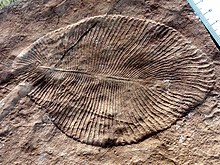Vendobionts

Vendobionten is the name for a hypothetical group of organisms riesenwüchsiger protozoa that in the era of Ediacariums (formerly Vendian called) have lived and most of the Ediacaran fossil fauna should account. The idea named according to the vendobiont hypothesis was formulated by the German paleontologist Adolf Seilacher .
features
The representatives of the Ediacara fauna were predominantly flat organisms with a feathery structure, their fossil prints reminiscent of fern fronds or fish fillets . Although they were only a few millimeters thick, they could sometimes reach a length of over a meter. They did not have any hard parts, such as a skeleton or a tank. There is much speculation about its internal and external structure. The appearance of these organisms is often compared to thin, liquid-filled air mattresses. The pinnate structure is seen by the supporters of the Vendobiont theory as a chamber, with which the organisms circumvented the size limitation of unicellular organisms. The size and chamber would then require that the cytoplasm was supplied with genetic information from several cell nuclei distributed in the plasma, as with other multinucleated unicellular organisms. Recent associations with undivided cytoplasm that are not divided by cell membranes and numerous cell nuclei are known as syncytium .
Way of life
There is little evidence of the vendobionts' way of life. From an extensive lack of fossil traces of movement, it was concluded that most of their representatives were immobile. Probably mobile representatives grazed and digested the lawn of microorganisms (bio mat) that was spread on the seabed at that time. For the immobile forms, in particular anchored in the substrate, upstanding in life "ferns" -Organismen is often a receptacle dissolved organic molecules from the sea water (Osmotrophie) assumed a symbiotic relationship with microorganisms is discussed. From the lack of bite marks on fossils of the Ediacarium, it was concluded that the Vendobionts were neither predators nor were they exposed to them.
Their practically complete disappearance at the beginning of the Cambrian era poses many puzzles to researchers. Possibly they were easy victims of the first prey hunters. Their livelihood, the bio mat, may have been destroyed by organisms that burrowed or built burrows in the soft substrates of the seabed.
Systematics
The systematic classification of the organisms known as vendobiotes is uncertain and is a matter of controversy. Some paleontologists doubt that the organisms are related to living things today, they consider them an extinct realm. Adolf Seilacher, the creator of the vendobiont hypothesis, assigned them to the protozoa and referred to them as "unicellular dinosaurs". Other scientists assign them to the realm of the multicellular animals ( Metazoa ). Based on their characteristics, they have been compared to cnidarians , polystyrene or vortex worms , for example . An assignment to the animal strain of the placozo is also discussed. In the case of assignment to the Metazoa, however, they are no longer referred to as vendobionts.
An assignment to other realms of living beings was also discussed. Possibly they were fungi, which optionally lived as lichens in symbiosis with photosynthetic microorganisms .
The following genera were assigned to the vendobionts:
- Charnia
- Charniodiscus
- Dickinsonia
- Ernietta
- Glaessneria
- Paracharnia
- Phyllozoon
- Protechiurus
- Pteridinium
- Rangea
- Spriggina
- Yorgia
Discovery story
The discovery of the Ediacaran fauna goes back to the Australian geologist Reginald Claude Sprigg . During excursions in the Ediacara Hills north of the Australian city of Adelaide , he discovered fossils of unique prehistoric soft-body organisms, which he first dated to the early Cambrian . The term "Vendobionts" goes back essentially to the German geologist Adolf Seilacher, who initially grouped these living beings into a separate kingdom ("Vendozoa") and later into a separate animal strain .
Web links
Individual evidence
- ↑ a b Seilacher A, Grazhdankin D, Legouta A: Ediacaran biota: The dawn of animal life in the shadow of giant protists . In: Paleontological Research . 7, No. 1, 2003, pp. 43-54.
- ^ Dzik J: The Verdun Syndrome: simultaneous origin of protective armor and infaunal shelters at the Precambrian Cambrian transition . In: Geological Society, London, Special Publications . 286, 2007, pp. 405-414.
- ↑ Sperling EA, Vinther J: A placozoan affinity for Dickinsonia and the evolution of late Proterozoic metazoan feeding modes . In: Evolution & Development . 12, No. 2, 2010, pp. 201-209. doi : 10.1111 / j.1525-142X.2010.00404.x .
- ↑ Retallack GJ: Were the Ediacaran Fossils Lichens? . In: Paleobiology . 20, No. 4, 1994, pp. 523-544.
- ^ Sprigg RC: Early Cambrian (?) Jellyfishes from the Flinders Ranges, South Australia . In: Transactions of the Royal Society of South Australia . 71, 1947, pp. 212-224.
- ↑ Seilacher A: Vendozoa: Organismic construction in the Proterozoic biosphere . In: Lethaia . 22, No. 3, 1989, pp. 229-239. doi : 10.1111 / j.1502-3931.1989.tb01332.x .
- ↑ Buss WL, Seilacher A: The Phylum Vendobionta: A Sister Group of the Eumetazoa? . In: Paleobiology . 20, No. 1, 1994, pp. 1-4.